
AMD Radeon HD 4850
Written by John Yan on 7/6/2008 for
PC
More On:
Radeon HD 4850
AMD’s recent video card activity has been getting them back into the game as their recent cards have shown they are taking steps in the right direction. Well, if the next two cards coming out are any indication, AMD is back in a big way and giving NVIDIA a big run for their money. AMD’s launching the ATI Radeon HD 4800 series of cards and we have a look at their two initial offerings in the ATI Radeon HD 4850 and the ATI Radeon HD 4870.
 First let’s look at what makes the 4800 series tick. For starters the cards are built on a 55nm fabrication process. Until recently with NVIDIA’s 9800 GTX+ launch, the ATI Radeon HD 4800 series were the only video cards to do this. As you know, smaller die equals less power needed and heat generated as well as decreasing the cost of producing the cards. AMD is able launch these cards at a very affordable price partially due to this.
First let’s look at what makes the 4800 series tick. For starters the cards are built on a 55nm fabrication process. Until recently with NVIDIA’s 9800 GTX+ launch, the ATI Radeon HD 4800 series were the only video cards to do this. As you know, smaller die equals less power needed and heat generated as well as decreasing the cost of producing the cards. AMD is able launch these cards at a very affordable price partially due to this.
The GPU codenamed R770 has been in the works for over two and a half years. Efficiency was one of the key goals and the engineering team worked really hard to make sure this was achieved with the R770. Deficiencies in the R600 line were studied, redesigned, improved upon, and incorporated in the R770. 965 million transistors, 800 stream processors, 40 texture units, and 16 render back-ends are just some of the processing power the R770 features.
Memory comes in GDDR3 or GDDR5 flavors. Data rates on GDDR5 can be up to 5X that of GDDR3 and 4X that of GDDR4. GDDR5 isn’t just about speed as there are new error correction mechanisms to help increase accuracy in calculations. There aren’t any other video cards using GDDR5 out there currently so the 4870 series of cards is the first out of the gate with it onboard. The 4850s use the lower rated GDDR3 and it helps keep the costs of the video card lower using the lesser performing memory. While the new NVIDIA card is using a 512-bit memory bus, the 4800s use a 256-bit memory bus. What the 4870 lacks in width makes up for with speed though with the GDDR5 ram. The faster ram will help compete with the bandwidth of a 512-bit memory bus in the NVIDIA cards.
TeraScale is what they call their new graphics engine. The name comes from the fact that there’s at least a processing rate of one teraflop or more. Compared to the ATI Radeon HD 3870, that’s more than double what the previous generation’s card is capable of.
DirectX 10.1 is supported of courses so you’ll be ready for the latest games on a Vista operating system. As with previous cards, CrossfireX technology is also in play allowing for multiple cards to be linked together for improved performance. We’ll be looking at Crossfire performance in a future article but recent reports state that you can get performance close to or surpassing NVIDIA’s single configurations of the GeForce GTX 260 and GeForce GTX 280 at a lower price point. Up to four GPUs can be linked together if your motherboard and power supply supports it.T o help improve the quality of graphics in games, offers the basic anti-aliasing modes as well as their Edge Detection technology as well. Various filters are used to help improve the image as the AMD hardware detects edges and applies them in those areas. Theoretically, you will get three times the sample rate with the advanced filtering methods. The AMD 4800 series increases the speed at which this can be achieved. In some cases, you can turn up to 8X AA with a minor performance hit over 4X AA.
Video support has always been a big part of the Radeon series of cards and the 4800 set is no exception. Unified Video Decoder 2 helps process video and alleviates the CPU from doing the work thereby offering smooth video playback. Codecs supported include VC-1, H.264, and MPEG-2. When converting video, you can get almost double the speed of real time for high definition video conversion. The HD 4800 series can upscale content past 1080p resolution so it can even enhance DVD picture quality on big displays. With onboard HDCP you’ll be able to view all your HDCP protected content on HDCP supported displays. The series also features an HDMI connection so you can pipe both video and audio through one connection on the video card.
So in a nutshell, we have a very feature rich set for the ATI Radeon HD 4800 line of cards. Below is a quick rundown of features for the cards
.
ATI Radeon™ HD 4800 Series - GPU Specifications

Specification wise, the ATI Radeon HD 4850 runs at a core clock speed of 625 MHz with memory at 2GHz. There are 512MB onboard. As previously mentioned the R770 contains 965 million transistors, 800 stream processors, 40 texture units, and 16 render back-ends. For all this you can pick up a card for $199 which is a pretty damn good price. The card looks to compete with NVIDIA’s GeForce 8800GT/GTS line. The review sample didn’t come with anything else other than the card though but the box does describe what is included. For starters, a component connector lets you connect to TVs with the same input. Older TVs with composite and S-Video connections is also supported with an included cable. For VGA owners, a DVI-VGA convertor is included. HDMI display owners will be pleased to see a DVI-HDMI convertor packaged in. Finally, a flexible Crossfire connector rounds out the packaged goods.
As you can see, there are two dual-linked DVI connectors and video out connector. Two Crossfire connectors are located on the top front edge of the card. The single slot card only needs one six pin power connector attached drawing a maximum of 110W. Lengthwise, it’s nice to see cards returning to a more normal length. It’s slightly shorter than the GeForce 8800 GTS and the Radeon HD 4870. You won’t have to worry about the 4850 fitting into your case. You can see the comparisons of the card lengths in the pictures below.
Feature for feature, the ATI Radeon HD 4850 is the exact same as the higher end ATI Radeon HD 4870 except for clock speed and memory type. There’s no elimination of processors or computational units for the lower end card which is great for a company to do. Many times you’ll see the lower end card get half of the hardware of the higher end cards to justify the cost but AMD went a different route this time that doesn’t gimp the card in a negative way.The testing setup includes
First up is the 3DMark Vantage from Futuremark.

 Crysis is the current game that pushes video cards to their limit. The latest from Crytek, Crysis offers some of the most incredible visuals you see today on the PC. For the test we ran through a flyby around the island that lasted about 4 minutes and recorded the average frames per second. Resolution was set at 1600x1200.
Crysis is the current game that pushes video cards to their limit. The latest from Crytek, Crysis offers some of the most incredible visuals you see today on the PC. For the test we ran through a flyby around the island that lasted about 4 minutes and recorded the average frames per second. Resolution was set at 1600x1200.
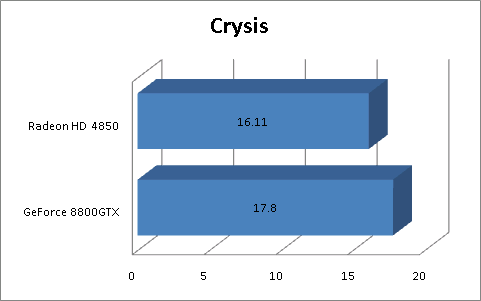

To see how well it overclocked, I used AMD’s Overdrive feature to see how much I can push it. The stock speeds for the Radeon HD 4850 sits at 625MHz for the core and 993MHz for the memory. With Overdrive, I was able to push the core and memory to 690MHz and 1168MHz respectively. That’s a 10% increase in the core and a 15% increase on memory speeds. I ran a few tests below with the new speeds.
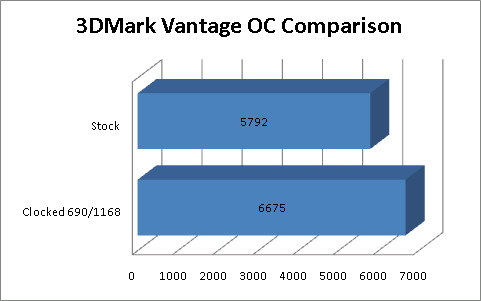
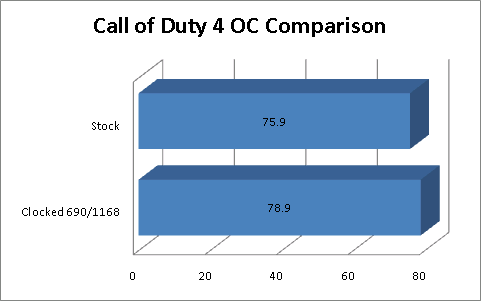
While there was a significant boost in 3D Mark Vantage, I got an average of 3 frames per second extra in Call of Duty 4. Compared to a Radeon HD 4870 at stock speed, which I will publish in the next day or two, the overclocked card does come close to matching the performance in Call of Duty 4 and surpassed the 3D Mark Vantage score by about 20GPU marks. I had the fan running at 65% capacity producing a loud but tolerable sound when I overclocked the card. At $100 less, this you can push the card and get close to Radeon HD 4870 speeds at a very nice price.
Speaking of the fan, the current drivers have the speed and ramp up at a very low setting so it runs pretty quiet at stock speeds but gets pretty hot when running 3D applications. When manually setting the fan’s speed at 40% and above, it gets pretty loud. Running at the normal setting, the temperature that it got was well within the specifications that AMD outlined. I’m sure other manufactures will put their spin on using different coolers to quiet it down and to overclock the card with a reasonable noise level but the stock card is quiet in normal settings.
At $199, it’s no comparison as to which is a better buy. The drivers aren’t even matured yet so you can expect a few more tweaks here and there to get more out of the card. AMD has really come back strong with the Radeon HD 4850 and offered great performance at a very, very affordable price. Overclocking the card can give you performance that’s close to the Radeon HD 4870 making it a great bang for the buck. I tip my hat to you AMD and it’s finally great to see a card exceed people’s expectations and excel in a very tough market. Well done red team, well done.

The GPU codenamed R770 has been in the works for over two and a half years. Efficiency was one of the key goals and the engineering team worked really hard to make sure this was achieved with the R770. Deficiencies in the R600 line were studied, redesigned, improved upon, and incorporated in the R770. 965 million transistors, 800 stream processors, 40 texture units, and 16 render back-ends are just some of the processing power the R770 features.
Memory comes in GDDR3 or GDDR5 flavors. Data rates on GDDR5 can be up to 5X that of GDDR3 and 4X that of GDDR4. GDDR5 isn’t just about speed as there are new error correction mechanisms to help increase accuracy in calculations. There aren’t any other video cards using GDDR5 out there currently so the 4870 series of cards is the first out of the gate with it onboard. The 4850s use the lower rated GDDR3 and it helps keep the costs of the video card lower using the lesser performing memory. While the new NVIDIA card is using a 512-bit memory bus, the 4800s use a 256-bit memory bus. What the 4870 lacks in width makes up for with speed though with the GDDR5 ram. The faster ram will help compete with the bandwidth of a 512-bit memory bus in the NVIDIA cards.
TeraScale is what they call their new graphics engine. The name comes from the fact that there’s at least a processing rate of one teraflop or more. Compared to the ATI Radeon HD 3870, that’s more than double what the previous generation’s card is capable of.
DirectX 10.1 is supported of courses so you’ll be ready for the latest games on a Vista operating system. As with previous cards, CrossfireX technology is also in play allowing for multiple cards to be linked together for improved performance. We’ll be looking at Crossfire performance in a future article but recent reports state that you can get performance close to or surpassing NVIDIA’s single configurations of the GeForce GTX 260 and GeForce GTX 280 at a lower price point. Up to four GPUs can be linked together if your motherboard and power supply supports it.T o help improve the quality of graphics in games, offers the basic anti-aliasing modes as well as their Edge Detection technology as well. Various filters are used to help improve the image as the AMD hardware detects edges and applies them in those areas. Theoretically, you will get three times the sample rate with the advanced filtering methods. The AMD 4800 series increases the speed at which this can be achieved. In some cases, you can turn up to 8X AA with a minor performance hit over 4X AA.
Video support has always been a big part of the Radeon series of cards and the 4800 set is no exception. Unified Video Decoder 2 helps process video and alleviates the CPU from doing the work thereby offering smooth video playback. Codecs supported include VC-1, H.264, and MPEG-2. When converting video, you can get almost double the speed of real time for high definition video conversion. The HD 4800 series can upscale content past 1080p resolution so it can even enhance DVD picture quality on big displays. With onboard HDCP you’ll be able to view all your HDCP protected content on HDCP supported displays. The series also features an HDMI connection so you can pipe both video and audio through one connection on the video card.
So in a nutshell, we have a very feature rich set for the ATI Radeon HD 4800 line of cards. Below is a quick rundown of features for the cards
.
ATI Radeon™ HD 4800 Series - GPU Specifications
- 956 million transistors on 55nm fabrication process
- PCI Express 2.0 x16 bus interface
- 256-bit GDDR3/4/5 memory interface
- Microsoft® DirectX® 10.1 support
- Shader Model 4.1
- 32-bit floating point texture filtering
- Indexed cube map arrays
- Independent blend modes per render target
- Pixel coverage sample masking
- Read/write multi-sample surfaces with shaders
- Gather4 texture fetching
- Unified Superscalar Shader Architecture
- 800 stream processing units
- Dynamic load balancing and resource allocation for vertex, geometry, and pixel shaders
- Common instruction set and texture unit access supported for all types of shaders
- Dedicated branch execution units and texture address processors
- 128-bit floating point precision for all operations
- Command processor for reduced CPU overhead
- Shader instruction and constant caches
- Up to 160 texture fetches per clock cycle
- Up to 128 textures per pixel
- Fully associative multi-level texture cache design
- DXTC and 3Dc+ texture compression
- High resolution texture support (up to 8192 x 8192)
- Fully associative texture Z/stencil cache designs
- Double-sided hierarchical Z/stencil buffer
- Early Z test, Re-Z, Z Range optimization, and Fast Z Clear
- Lossless Z & stencil compression (up to 128:1)
- Lossless color compression (up to 8:1)
- Up to 8 render targets (MRTs) with anti-aliasing
- Accelerated physics processing
- 800 stream processing units
- Dynamic Geometry Acceleration
- High performance vertex cache
- Programmable tessellation unit
- Accelerated geometry shader path for geometry amplification
- Memory read/write cache for improved stream output performance
- Anti-aliasing features
- Multi-sample anti-aliasing (2, 4, or 8 samples per pixel)
- Up to 24x Custom Filter Anti-Aliasing (CFAA) for improved quality
- Adaptive super-sampling and multi-sampling
- Gamma correct
- Super AA (ATI CrossFireX™ configurations only)
- All anti-aliasing features compatible with HDR rendering
- Texture filtering features
- 2x/4x/8x/16x high quality adaptive anisotropic filtering modes (up to 128 taps per pixel)
- 128-bit floating point HDR texture filtering
- sRGB filtering (gamma/degamma)
- Percentage Closer Filtering (PCF)
- Depth & stencil texture (DST) format support
- Shared exponent HDR (RGBE 9:9:9:5) texture format support
- OpenGL 2.0 support
- ATI Avivo™ HD Video and Display Platform
- Unified Video Decoder 2 (UVD 2) for H.264/AVC, VC-1, and MPEG-2 video formats
- High definition (HD) playback of Blu-ray and HD DVD video
- Dual stream (HD+SD) playback support
- DirectX Video Acceleration 1.0 & 2.0 support
- Support for BD-Live certified applications
- Hardware DivX and MPEG-1 video decode acceleration
- Accelerated video transcoding & encoding for H.264 and MPEG-2 formats
- ATI Avivo Video Post Processor
- Color space conversion
- Chroma subsampling format conversion
- Horizontal and vertical scaling
- Gamma correction
- Advanced vector adaptive per-pixel de-interlacing
- De-blocking and noise reduction filtering
- Detail enhancement
- Color vibrance and flesh tone correction
- Inverse telecine (2:2 and 3:2 pull-down correction)
- Bad edit correction
- Enhanced DVD upscaling (SD to HD)
- Automatic dynamic contrast adjustment
- Two independent display controllers
- Drive two displays simultaneously with independent resolutions, refresh rates, color controls and video overlays for each display
- Full 30-bit display processing
- Programmable piecewise linear gamma correction, color correction, and color space conversion
- Spatial/temporal dithering provides 30-bit color quality on 24-bit and 18-bit displays
- High quality pre- and post-scaling engines, with underscan support for all display outputs
- Content-adaptive de-flicker filtering for interlaced displays
- Fast, glitch-free mode switching
- Hardware cursor
- Two integrated dual-link DVI display outputs
- Each supports 18-, 24-, and 30-bit digital displays at all resolutions up to 1920x1200 (single-link DVI) or 2560x1600 (dual-link DVI)
- Each includes a dual-link HDCP encoder with on-chip key storage for high resolution playback of protected content3
- Two integrated 400 MHz 30-bit RAMDACs
- Each supports analog displays connected by VGA at all resolutions up to 2048x1536
- DisplayPort output support
- 24- and 30-bit displays at all resolutions up to 2560x1600
- HDMI output support
- All display resolutions up to 1920x1080
- Integrated HD audio controller with support for stereo and multi-channel (up to 7.1) audio formats, including AC-3, AAC, DTS, DTS-HD & Dolby True-HD, enabling a plug-and-play audio solution over HDMI
- Integrated AMD Xilleon™ HDTV encoder
- Provides high quality analog TV output (component/S-video/composite)
- Supports SDTV and HDTV resolutions
- Underscan and overscan compensation
- Seamless integration of pixel shaders with video in real time
- VGA mode support on all display outputs
- Unified Video Decoder 2 (UVD 2) for H.264/AVC, VC-1, and MPEG-2 video formats
- ATI PowerPlay™ Technology
- Advanced power management technology for optimal performance and power savings
- Performance-on-Demand
- Constantly monitors GPU activity, dynamically adjusting clocks and voltage based on user scenario
- Clock and memory speed throttling
- Voltage switching
- Dynamic clock gating
- Central thermal management – on-chip sensor monitors GPU temperature and triggers thermal actions as required
- ATI CrossFireX™ Multi-GPU Technology
- Scale up rendering performance and image quality with two, three, or four GPUs
- Integrated compositing engine
- High performance dual channel bridge interconnect

Specification wise, the ATI Radeon HD 4850 runs at a core clock speed of 625 MHz with memory at 2GHz. There are 512MB onboard. As previously mentioned the R770 contains 965 million transistors, 800 stream processors, 40 texture units, and 16 render back-ends. For all this you can pick up a card for $199 which is a pretty damn good price. The card looks to compete with NVIDIA’s GeForce 8800GT/GTS line. The review sample didn’t come with anything else other than the card though but the box does describe what is included. For starters, a component connector lets you connect to TVs with the same input. Older TVs with composite and S-Video connections is also supported with an included cable. For VGA owners, a DVI-VGA convertor is included. HDMI display owners will be pleased to see a DVI-HDMI convertor packaged in. Finally, a flexible Crossfire connector rounds out the packaged goods.
As you can see, there are two dual-linked DVI connectors and video out connector. Two Crossfire connectors are located on the top front edge of the card. The single slot card only needs one six pin power connector attached drawing a maximum of 110W. Lengthwise, it’s nice to see cards returning to a more normal length. It’s slightly shorter than the GeForce 8800 GTS and the Radeon HD 4870. You won’t have to worry about the 4850 fitting into your case. You can see the comparisons of the card lengths in the pictures below.
Feature for feature, the ATI Radeon HD 4850 is the exact same as the higher end ATI Radeon HD 4870 except for clock speed and memory type. There’s no elimination of processors or computational units for the lower end card which is great for a company to do. Many times you’ll see the lower end card get half of the hardware of the higher end cards to justify the cost but AMD went a different route this time that doesn’t gimp the card in a negative way.The testing setup includes
- Intel E6400
- Biostar P45 Motherboard
- 2 GB PC-6400 DDR2 ram
- Windows Vista w/ Service Pack 1
First up is the 3DMark Vantage from Futuremark.

Here's the latest benchmark from the folks at Futuremark. Newly designed for Windows Vista and DirectX10, it includes two new graphics tests, two new CPU tests, several new feature tests, and support for the latest hardware. 3DMark Vantage is based on a completely new rendering engine, developed specifically to take full advantage of DirectX10, the new graphics API from Microsoft. What is reported below are just the GPU scores at the default settings.
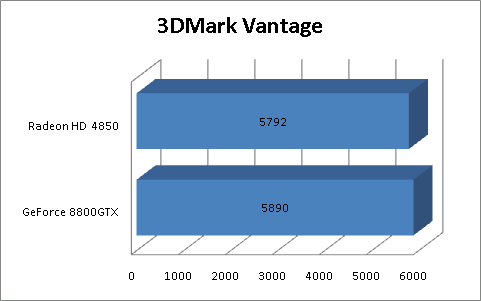



Call of Juarez is a First Person Shooter for PC, inspired from the greatest movies of the Western genre. It is the first 'serious' and the most realistic adaptation of the genre. Developed by Techland Studio, the game draws on the major themes of the American Wild West through confrontation between the two principal emblematic characters. I ran the benchmark program that was done up by Techland and set it to 1600x1200 resolution along with high shadows.
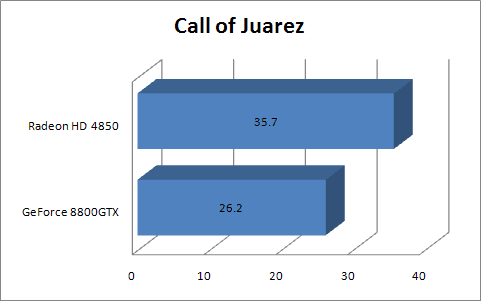



Company of Heroes is an RTS that really pushes video cards. The game by the fine folks at Relic Entertainment is set in WWII and features deformable terrain as well as great physics. The level of detail in the game for an RTS is amazing. For the tests, we set everything at maximum or ultra to ensure that the card was taxed as much as possible and the resolution was set at 1600x1200.
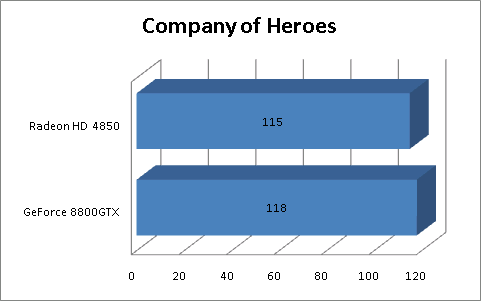




Call of Duty 4 is one of the best first person shooters released in 2008. The Call of Duty series makes its move to modern times with awesome graphics, intense battles, and great multiplayer action. The test was done at 1600x1200 resolution with a custom multiplayer demo that I recorded.
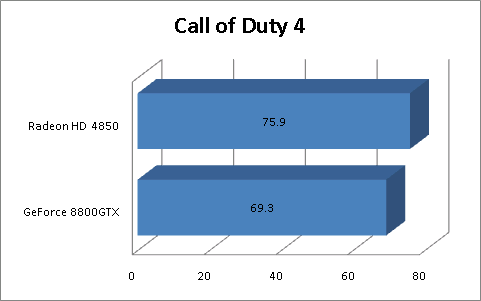
What else can you say but very well played, AMD, very well played. The Radeon HD 4850 surpassed my expectations on performance. Positioned to go up against a GeForce 8800GTS, the Radeon HD 4850 performed at or beyond the GeForce 8800GTX which is slightly faster than the 8800GTS in most cases.
Quality of graphics can be improved by turning on anti-aliasing. The Radeon HD 4850 boasts great performance at both 4X and 8X AA. To test, I ran Call of Juarez at 4X while running Call of Duty at 4X and 8X AA at 1600x1200 resolution.
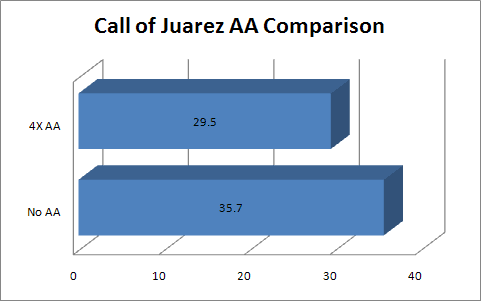

While there's a good jump in the loss of framerate going from no AA to 4X, the decrease in speed isn't as significant in Call of Duty 4 when going from 4X to 8X. Given the performance available, you can get very good framerates at high resolution with a good deal of AA turned on.

What else can you say but very well played, AMD, very well played. The Radeon HD 4850 surpassed my expectations on performance. Positioned to go up against a GeForce 8800GTS, the Radeon HD 4850 performed at or beyond the GeForce 8800GTX which is slightly faster than the 8800GTS in most cases.
Quality of graphics can be improved by turning on anti-aliasing. The Radeon HD 4850 boasts great performance at both 4X and 8X AA. To test, I ran Call of Juarez at 4X while running Call of Duty at 4X and 8X AA at 1600x1200 resolution.


While there's a good jump in the loss of framerate going from no AA to 4X, the decrease in speed isn't as significant in Call of Duty 4 when going from 4X to 8X. Given the performance available, you can get very good framerates at high resolution with a good deal of AA turned on.


While there was a significant boost in 3D Mark Vantage, I got an average of 3 frames per second extra in Call of Duty 4. Compared to a Radeon HD 4870 at stock speed, which I will publish in the next day or two, the overclocked card does come close to matching the performance in Call of Duty 4 and surpassed the 3D Mark Vantage score by about 20GPU marks. I had the fan running at 65% capacity producing a loud but tolerable sound when I overclocked the card. At $100 less, this you can push the card and get close to Radeon HD 4870 speeds at a very nice price.
Speaking of the fan, the current drivers have the speed and ramp up at a very low setting so it runs pretty quiet at stock speeds but gets pretty hot when running 3D applications. When manually setting the fan’s speed at 40% and above, it gets pretty loud. Running at the normal setting, the temperature that it got was well within the specifications that AMD outlined. I’m sure other manufactures will put their spin on using different coolers to quiet it down and to overclock the card with a reasonable noise level but the stock card is quiet in normal settings.
At $199, it’s no comparison as to which is a better buy. The drivers aren’t even matured yet so you can expect a few more tweaks here and there to get more out of the card. AMD has really come back strong with the Radeon HD 4850 and offered great performance at a very, very affordable price. Overclocking the card can give you performance that’s close to the Radeon HD 4870 making it a great bang for the buck. I tip my hat to you AMD and it’s finally great to see a card exceed people’s expectations and excel in a very tough market. Well done red team, well done.
It's affordable, performs well, has plenty of features, and can be pushed to close to Radeon HD 4870 speeds. AMD's really produced a great card in the Radeon HD 4850 giving consumers a great upgrade option.
Rating: 9.9 Exquisite
* The product in this article was sent to us by the developer/company.

About Author
I've been reviewing products since 1997 and started out at Gaming Nexus. As one of the original writers, I was tapped to do action games and hardware. Nowadays, I work with a great group of folks on here to bring to you news and reviews on all things PC and consoles.
As for what I enjoy, I love action and survival games. I'm more of a PC gamer now than I used to be, but still enjoy the occasional console fair. Lately, I've been really playing a ton of retro games after building an arcade cabinet for myself and the kids. There's some old games I love to revisit and the cabinet really does a great job at bringing back that nostalgic feeling of going to the arcade.
View Profile







